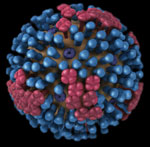Volume 24, Number 10—October 2018
Etymologia
Etymologia: Hemagglutinin and Neuraminidase
In 1941, virologist George K. Hirst discovered that adding influenza virus to red blood cells (erythrocytes) in a test tube caused the cells to agglutinate, mediated by one of the virus surface glycoproteins, hemagglutinin (from the Greek haima, “blood,” + Latin gluten, “glue”) (Figure). Alfred Gottschalk later showed that hemagglutinin binds virus to host cells by attaching to sialic acids (from the Greek sialon, “saliva”) on carbohydrate side chains of cell-surface glycoproteins and glycolipids. The other influenza virus surface protein, neuraminidase (referring to brain lipids from which it was first derived) is a virus receptor-destroying enzyme that removes its substrate, sialic acids, from infected cell surfaces so that newly made progeny viruses are released to infect additional cells. At present, 18 hemagglutinin subtypes (H1–H18) and 11 neuraminidase subtypes (N1–N11) are recognized.
References
- Gottschalk A. The chemistry and biology of sialic acids and related substances. London: Cambridge University Press; 1960.
- Hirst GK. The agglutination of red cells by allantoic fluid of chick embryos infected with influenza virus. Science. 1941;94:22–3. DOIPubMedGoogle Scholar
- Hirst GK. Adsorption of influenza hemagglutinins and virus by red blood cells. J Exp Med. 1942;76:195–209. DOIPubMedGoogle Scholar
Figure
Cite This ArticleOriginal Publication Date: September 04, 2018
Related Links
Table of Contents – Volume 24, Number 10—October 2018
| EID Search Options |
|---|
|
|
|
|
|
|

Please use the form below to submit correspondence to the authors or contact them at the following address:
Ronnie Henry, Centers for Disease Control and Prevention, 1600 Clifton Rd NE, Mailstop E03, Atlanta, GA 30329-4027, USA
Top